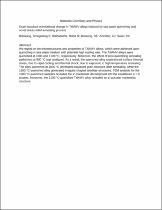 ResearchSpace
ResearchSpace
Grain structure orientational change in Ti6Al4V alloys induced by sea water quenching and novel stress relief annealing process
JavaScript is disabled for your browser. Some features of this site may not work without it.
- ResearchSpace
- →
- Research Publications/Outputs
- →
- Journal Articles
- →
- View Item
| dc.contributor.author |
Bolokang, Amogelang S

|
|
| dc.contributor.author |
Mathabathe, Maria N

|
|
| dc.contributor.author |
Motaung, DE

|
|
| dc.contributor.author |
Arendse, CJ

|
|
| dc.contributor.author |
Swart, HC

|
|
| dc.date.accessioned | 2023-02-26T20:22:17Z | |
| dc.date.available | 2023-02-26T20:22:17Z | |
| dc.date.issued | 2023-03 | |
| dc.identifier.citation | Bolokang, A.S., Mathabathe, M.N., Motaung, D., Arendse, C. & Swart, H. 2023. Grain structure orientational change in Ti6Al4V alloys induced by sea water quenching and novel stress relief annealing process. <i>Materials Chemistry and Physics, 297.</i> http://hdl.handle.net/10204/12631 | en_ZA |
| dc.identifier.issn | 0254-0584 | |
| dc.identifier.issn | 1879-3312 | |
| dc.identifier.uri | https://doi.org/10.1016/j.matchemphys.2023.127328 | |
| dc.identifier.uri | http://hdl.handle.net/10204/12631 | |
| dc.description.abstract | We report on the microstructures and properties of Ti6Al4V alloys, which were achieved upon quenching in sea water medium with potential high cooling rate. The Ti6Al4V alloys were quenched at 1000 and 1100 °C, respectively. Moreover, the effect of post-quenching annealing performed at 900 °C was analyzed. As a result, the quenched alloy experienced surface thermal stress, due to rapid cooling and thermal shock, due to exposure to high temperature annealing. The alloy quenched at 1000 °C developed equiaxed grain structure after annealing, while the 1100 °C-quenched alloy generated irregular shaped lamellae structures. TEM analysis for the 1000 °C-quenched samples revealed the a'-martensite decomposed into the equilibrium a + ß phases. Moreover, the 1100 °C-quenched Ti6Al4V alloy revealed an a'-acicular martensitic structure. | en_US |
| dc.format | Abstract | en_US |
| dc.language.iso | en | en_US |
| dc.relation.uri | https://www.sciencedirect.com/science/article/pii/S0254058423000366 | en_US |
| dc.source | Materials Chemistry and Physics, 297 | en_US |
| dc.subject | Electron backscatter diffraction | en_US |
| dc.subject | EBSD | en_US |
| dc.subject | Grain orientation | en_US |
| dc.subject | Microstructure | en_US |
| dc.subject | Sea water quenching | en_US |
| dc.subject | Ti6Al4V alloy | en_US |
| dc.title | Grain structure orientational change in Ti6Al4V alloys induced by sea water quenching and novel stress relief annealing process | en_US |
| dc.type | Article | en_US |
| dc.description.pages | 10 | en_US |
| dc.description.note | © 2023 Elsevier B.V. All rights reserved. Due to copyright restrictions, the attached PDF file only contains the abstract of the full text item. For access to the full text item, please consult the publisher's website: https://www.sciencedirect.com/science/article/pii/S0254058423000366 | en_US |
| dc.description.cluster | Manufacturing | en_US |
| dc.description.impactarea | Powder Metallurgy Technologies | en_US |
| dc.description.impactarea | Advanced Casting Technologies | en_US |
| dc.identifier.apacitation | Bolokang, A. S., Mathabathe, M. N., Motaung, D., Arendse, C., & Swart, H. (2023). Grain structure orientational change in Ti6Al4V alloys induced by sea water quenching and novel stress relief annealing process. <i>Materials Chemistry and Physics, 297</i>, http://hdl.handle.net/10204/12631 | en_ZA |
| dc.identifier.chicagocitation | Bolokang, Amogelang S, Maria N Mathabathe, DE Motaung, CJ Arendse, and HC Swart "Grain structure orientational change in Ti6Al4V alloys induced by sea water quenching and novel stress relief annealing process." <i>Materials Chemistry and Physics, 297</i> (2023) http://hdl.handle.net/10204/12631 | en_ZA |
| dc.identifier.vancouvercitation | Bolokang AS, Mathabathe MN, Motaung D, Arendse C, Swart H. Grain structure orientational change in Ti6Al4V alloys induced by sea water quenching and novel stress relief annealing process. Materials Chemistry and Physics, 297. 2023; http://hdl.handle.net/10204/12631. | en_ZA |
| dc.identifier.ris | TY - Article AU - Bolokang, Amogelang S AU - Mathabathe, Maria N AU - Motaung, DE AU - Arendse, CJ AU - Swart, HC AB - We report on the microstructures and properties of Ti6Al4V alloys, which were achieved upon quenching in sea water medium with potential high cooling rate. The Ti6Al4V alloys were quenched at 1000 and 1100 °C, respectively. Moreover, the effect of post-quenching annealing performed at 900 °C was analyzed. As a result, the quenched alloy experienced surface thermal stress, due to rapid cooling and thermal shock, due to exposure to high temperature annealing. The alloy quenched at 1000 °C developed equiaxed grain structure after annealing, while the 1100 °C-quenched alloy generated irregular shaped lamellae structures. TEM analysis for the 1000 °C-quenched samples revealed the a'-martensite decomposed into the equilibrium a + ß phases. Moreover, the 1100 °C-quenched Ti6Al4V alloy revealed an a'-acicular martensitic structure. DA - 2023-03 DB - ResearchSpace DP - CSIR J1 - Materials Chemistry and Physics, 297 KW - Electron backscatter diffraction KW - EBSD KW - Grain orientation KW - Microstructure KW - Sea water quenching KW - Ti6Al4V alloy LK - https://researchspace.csir.co.za PY - 2023 SM - 0254-0584 SM - 1879-3312 T1 - Grain structure orientational change in Ti6Al4V alloys induced by sea water quenching and novel stress relief annealing process TI - Grain structure orientational change in Ti6Al4V alloys induced by sea water quenching and novel stress relief annealing process UR - http://hdl.handle.net/10204/12631 ER - | en_ZA |
| dc.identifier.worklist | 26450 | en_US |





